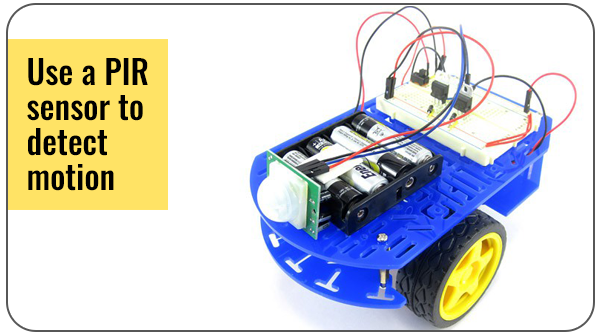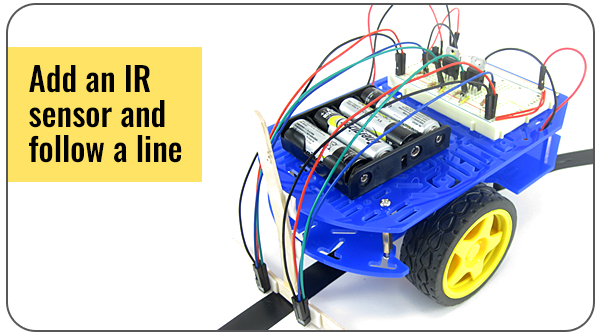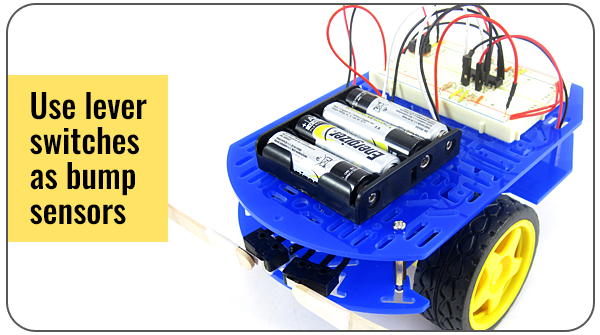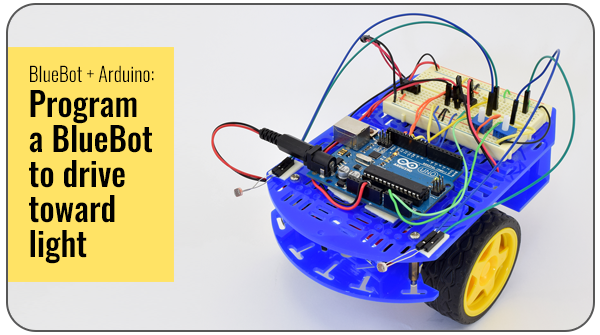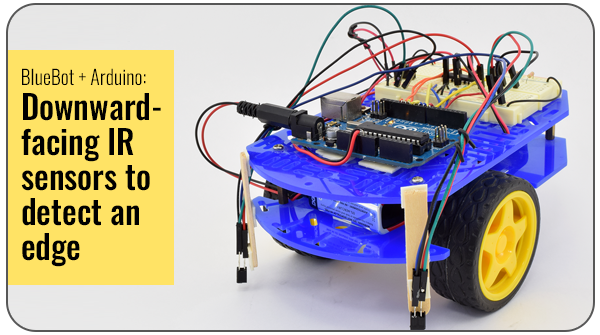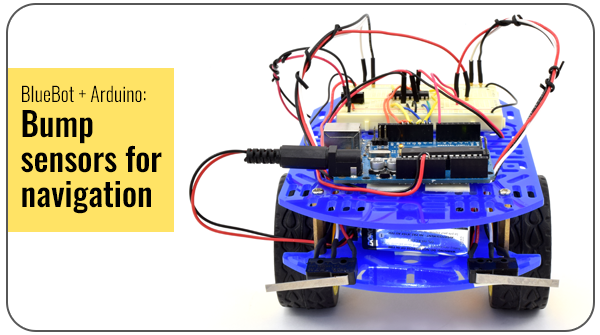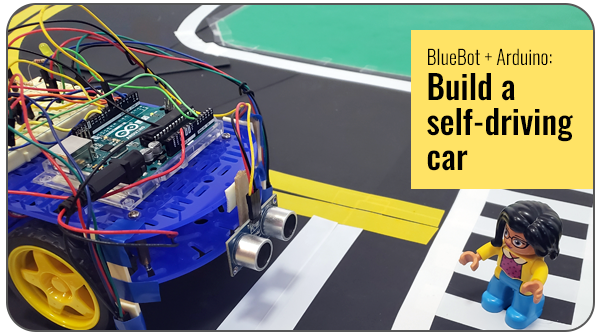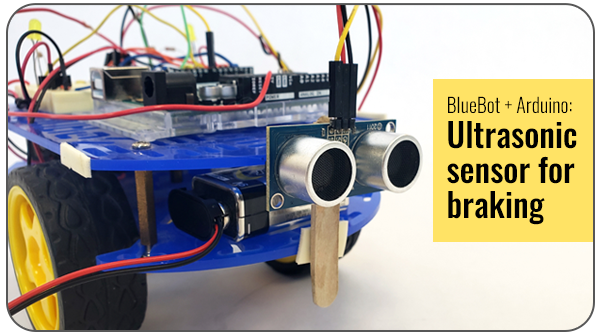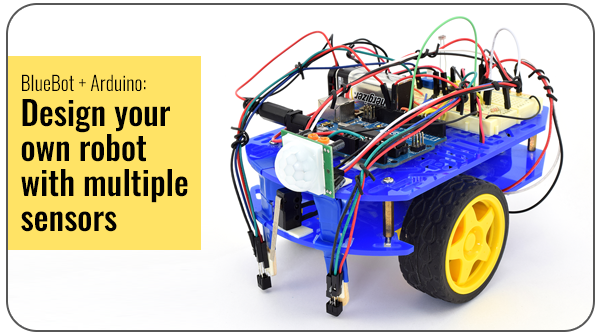10+ Robotics Projects with the BlueBot Kit
Use the BlueBot Robotics kit for a progressive series of robotics engineering and Arduino programming and physical computing projects, from intermediate to advanced.
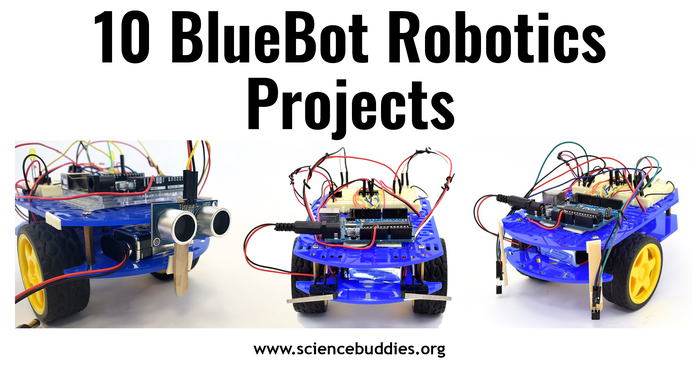
The BlueBot 4-in-1 Robotics Kit comes with the electronics parts to build four different robots, each with its own sensor-driven behavior. The kit is excellent as a starter kit for students interested in robotics engineering and ready to build circuits on a breadboard, and the first four projects provide step-by-step directions. The BlueBot chassis can be used for a wide range of other robotics engineering projects and is a good robotics base for developing and exploring programming with Arduino.
The BlueBot projects highlighted below scale in difficulty from intermediate to advanced. For introductory projects and other robotics engineering explorations, see the 25+ Robotics Projects, Lessons, and Activities resource and beginner-friendly projects using the Bristlebot Robotics Kit.
Get Started with BlueBot
Most BlueBot projects use the yellow and blue chassis. This video guides students through standard assembly of the chassis.
The Core "Sensor" Series
The BlueBot Kit contains the BlueBot chassis and electronics parts to build the following four starter robots (one at a time), each with a different sensor-based behavior:
- Build a Motion-Activated Guard Robot (BlueBot Project #1): Build a motion-activated guard robot and adjust its behavior to avoid false alarms. This BlueBot uses a passive infrared (PIR) sensor to detect motion.
- Build a Speedy Light-Tracking Robot (BlueBot Project #2): Build a light-tracking robot and make adjustments to improve the robot's performance. This BlueBot uses photoresistors to detect light and potentiometers to adjust the robot's sensitivity to light levels; together, these elements work as a voltage divider that enables the robot to detect and follow a beam of light.
- Build a Zippy Line-following Robot (BlueBot Project #3): Build a line-following robot and make adjustments so it can follow a line on the floor without going off-course. This BlueBot uses an IR sensor that contains an emitter (an IR light-emitting diode (LED)) and a detector (an IR phototransistor). The IR sensor allows the robot to detect nearby reflective objects.
- Build an Obstacle-Avoiding Robot (BlueBot Project #4): Build an obstacle-avoiding robot and improve the design to help it avoid getting stuck. This BlueBot uses lever switches that serve as the robot's bump sensors.
Next Steps with BlueBot — Add Arduino
After building the basic BlueBot robots and exploring circuits with sensors, students can extend and customize their BlueBot robots by using an Arduino and programming the robot for specific behaviors.
The videos in our multi-part How to Use Arduino series are designed to help students get started using Arduino and exploring physical computing. This tutorial prepares students for doing electronics and robotics projects that use Arduino. Students can watch these videos in advance or as needed when building new Arduino and programming skills.
Now available! The Electronics Kit for Arduino is available for students working on electronics, coding, and physical computing projects using Arduino. (See the "Materials" section for each project for a complete list of materials required.)
BlueBot + Programming
The following projects challenge students to combine robotics and programming with BlueBot + Arduino to create robots with a range of interesting behaviors that can be compared to real-world examples like Perseverance, the Mars rover, and autonomous (or self-driving) cars.
- Build a Solar-Tracking Robot: Build and program a robot that can autonomously drive towards a light source.
- Keep Your Arduino Robot From Falling Off a Cliff: Build and program a robot that can use infrared sensors to avoid driving off the edge of a table.
- Build an Autonomous Arduino Robot with Bump Sensors: Use switches to serve as bump sensors and program a robot that can move forward, back up, and navigate around a space without getting stuck. This ability is important in small devices like robotic vacuums but also in larger robots and cars, too.
- Build a Miniature Self-Driving Car: Build a self-driving robot that can safely navigate a model roadway as part of an investigation of autonomous vehicles.
- How Fast is Automatic Braking?: Use a robot to simulate a self-driving car and experiment to see if automatic braking is faster than manual braking.
- Build an Arduino Robot: Design and program a robot with multiple sensors for a specific use.
- Build a Sound-Tracking Search and Rescue Robot: Build a sound-tracking robot that uses two microphones to drive toward a sound source.
For additional physical computing and Arduino science projects, see Arduino Science Projects.
BlueBot Videos
The following STEM videos demonstrate some of the BlueBot projects described above:
Multi-use BlueBot Robotics Kit
The BlueBot 4-in-1 Robotics Kit contains the chassis and electronics parts to get started with the first set of four BlueBot projects. The kit can then be extended (with Arduino and additional parts) for a range of intermediate and advanced robotics experiments.
BlueBot Building in Action
These posts show students assembling the BlueBot and building circuits for many of the projects described above.
For more robotics projects and activities for K-12 students, see 25+ Robotics Projects, Lessons, and Activities.
Categories:
You Might Also Enjoy These Related Posts:
- 10+ Robotics Projects with the BlueBot Kit
- 15 STEM Gifts & Science Kits You'll Feel Good About Giving
- 12 Science Kits for Summer Science Experiments and Discovery
- Build a Water Sensor Circuit for the Tree
- Science Project Kits - Our top 10 list!
- Explore Coding and Electronics with Raspberry Pi
- Three new Science Kits for K-12 STEM
- Shoebox STEM: A 4-H Success Story



